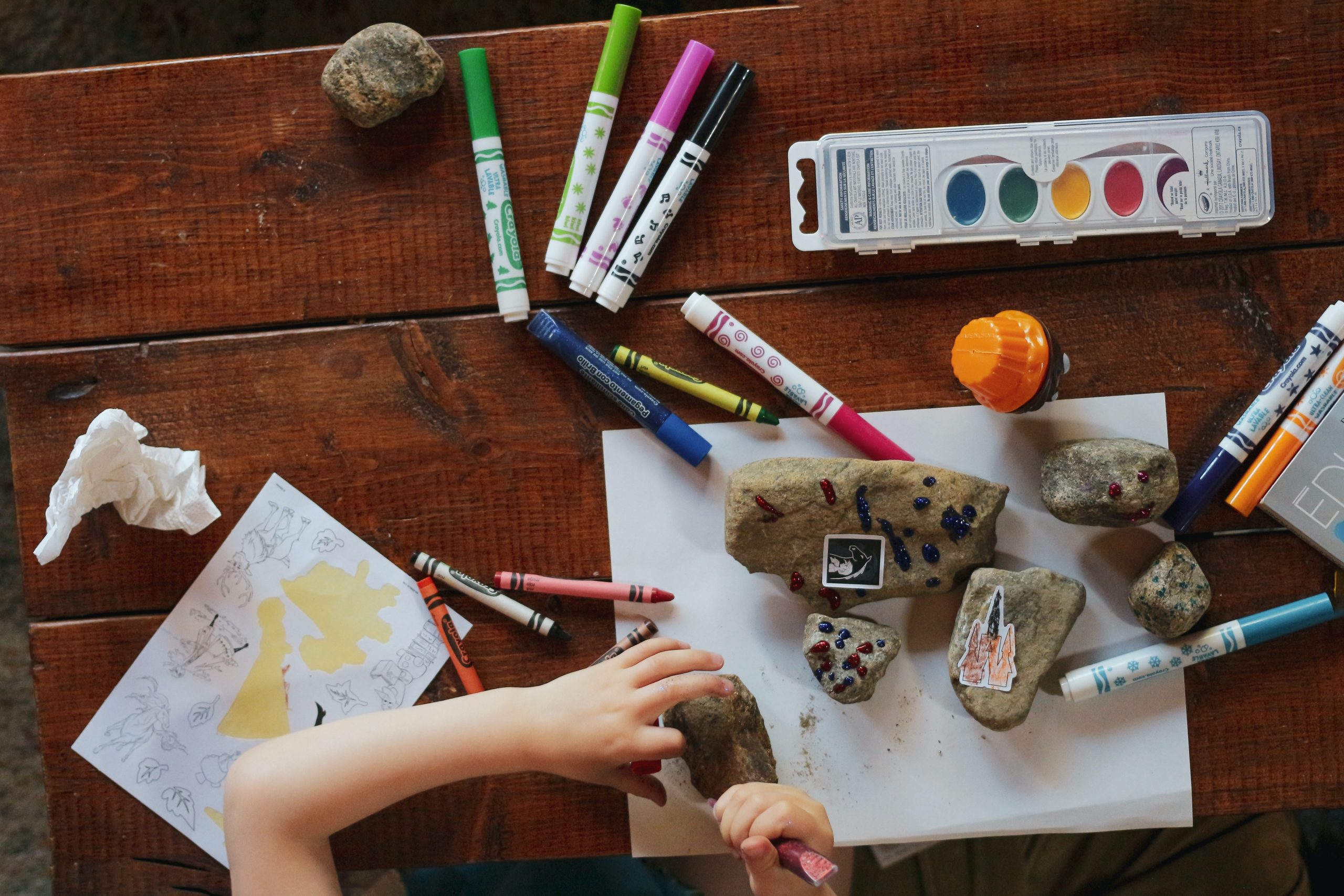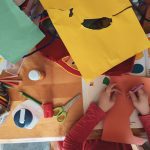The Magic of Boredom: Part 1
I notice the magic in myself, sometimes—in the moments of calm-despite-the-chaos of new parenthood, where I find those precious moments when I can steal away to the delightful space of mental wandering.
This is where magic happens.
Often, I wonder if my creativity has waned in adulthood. Maybe this is true. Or maybe the space for creativity has been drastically reduced under the weight of naturally-occurring responsibilities that snowball with each new season of life.
Boredom, or at least some stillness of the mind, begets creativity. Adults must often carve this space out for themselves or seize the moments when they come. But for children, a little boredom is absolutely essential for healthy development.
“Children need to sit in their own boredom for the world to become quiet enough that they can hear themselves” – Dr. Vanessa Lapointe [3]
My daughter is only 8 months old, but I have already found myself falling into the cultural trend of over-structuring her playtime. As her “wake windows” first began to lengthen, I remember telling a friend, “I am running out of content to entertain her this long!” Luckily, the constant pressure to entertain my child is not part of my job as her mother. Facilitating her safety and opportunity to explore her world, is.
I don’t need 3 different sensory bins a day to create a Pinterest-perfect childhood for her. Her world already is a sensory bin in itself! Allowing her to explore that world with my support helps build executive function and physical literacy.
Let’s slow down and define those terms for a moment.
Executive function refers to the brain’s cognitive control system that allows us to manage things such as the connection between our thoughts and actions, planning and decision-making, self-control, and task management [1].
Children learn executive function through practical application and opportunities to use these skills.
Physical Literacy “is defined as the ability to move with competence and confidence in a wide variety of physical activities in multiple environments that benefit the healthy development of the whole person” [4].
Children best learn how to use their physical bodies through activity (no kidding), and thus strengthen the parts of the brain needed to support balance, flexibility of physical tasks across different environments, and hand/eye coordination.
Both of these developmental areas involve a little child-lead exploration and opportunity to make decisions for themselves without adult instruction. As you may guess, some children may experience these opportunities as “boring” if they are used to having most of their days structured for them.
But remember, “if you don’t give kids the chance to manage their time, they won’t learn how to manage their time” [5].
I am sure most of us can think of a time in childhood in which boredom turned into a rich imaginative experience, or the creation of a new game, or a challenge to overcome a new task. For my brothers and me, it was learning how to walk with the stilts my grandfather built for us, or creating an in-depth game of pretend that could last hours upon hours.
Research overwhelmingly suggests that children need ample time to practice physical and cognitive skills without specific directions from adults. That, my friends, is where the magic happens for children.
A 2014 study determined that executive function was higher in children who spent time in less-structured activities, demonstrating better self-directed control than their peers who spent more time in adult-directed activities [1].
Unfortunately, however, most children live in an adult-structured world completely unsuited for their need for developmentally-appropriate exploration. School-aged children especially sit for long hours at a time, and the few times they are offered a chance to move, such as in PE class at school, it with a purposeful game or teacher-lead activity. While these structured activities are certainly beneficial for areas of growth and relational skills, research tells us that children also need opportunities to decide on their own tasks, game, or activity to independently nurture key skills of cognitive and physical development [1, 7]. Open-ended play is where these skills are fine-tuned and given room to mature.
If children are not offered time to explore their own creativity, they will do so when teachers least want them to. This is an age-old scene. I mean, surely I am not the only one who wrote fictional stories or drew doodles during history class, right? That type of boredom absolutely leads to creativity—but not at the time or place that the presiding educator wanted us to be daydreaming.
Boredom, facilitated through less-structured play time, is a better space for this than history class.
Stephanie Lee, PsyD, and director of the ADHD and Behavior Disorders Center at the Child Mind Institute, agrees with these assertions and states that practicing boredom, while not always initially pleasant for a child, helps him or her develop distress tolerance for when a situation is not going the way the child would prefer. Boredom creates an opportunity to “manage and regulate” emotions, a skill that Jodi Musoff, MA, MEd, an education specialist at the Child Mind Institute, states that children who are often used to highly-structured environments may not develop as optimally.
But what is it about boredom that is so magical for actually developing these skills?
Well, when children have to decide how to spend their time, they must use executive function skills such as planning, organizing, and problem-solving [1].
Now, I am not advocating for a completely laissez-faire style of parenting. Structure is both necessary and supportive for children (and adults) of all ages. As we all know, structure provides a predictable foundation for safety and support for kids to operate as kids without feeling pressure regarding meal time, sleep time, or playtime. Offering predictable, unstructured time (also known as “Independent Play Time”) gives a child ample opportunity to practice the executive skills that adults have been modeling for them throughout structured times of the day.
I recognize that it can be a little daunting to allow your child to be bored and work through the initial fussiness of their distress. Before they settle into their chosen activity, they will most assuredly tell you that they are bored no less than 34 times. However, knowing that the result of their boredom (and your momentary frustration) is increased creativity and executive function hopefully provides a positive motivation for your family to work through these times of boredom together.
Be sure to check back in with us next week for Part 2: Fostering Creativity through Boredom for practical ideas to make the most of your child’s boredom!
Resources:
1. Barker, J. E., Semenov, A. D., Michaelson, L., Provan, L. S., Snyder, H. R., & Munakata, Y. (2014, June 17). Less-structured time in children’s daily lives predicts self-directed executive functioning. Frontiers. Retrieved June 19, 2022, from https://www.frontiersin.org/articles/10.3389/fpsyg.2014.00593/full
2. Belton, T. (2016, September 16). Want to be a great parent? Let your children be bored. World Economic Forum. Retrieved June 20, 2022, from https://www.weforum.org/agenda/2016/09/being-bored-is-good-for-children-and-adults-this-is-why?utm_content=bufferb8f6b&utm_medium=social&utm_source=twitter.com&utm_campaign=buffer
3. The benefits of boredom. Melbourne Child Psychology & School Psychology Services. (2016, December 19). Retrieved June 20, 2022, from https://www.melbournechildpsychology.com.au/blog/the-benefits-of-boredom/
4. Gehris, J. S., Simpson, A. C., Baert, H., Robinson, L. E., MacDonald, M., Clements, R., Logan, S., & Schneider, S. (2018, August). Resource to share with parents: Helping your child develop physical literacy. Physical Education and Health Education-Shape America. Retrieved June 25, 2022, from https://www.shapeamerica.org/
5. Grove, J. (2016, September 25). Study suggests that kids suffer from too much structured activity. Active For Life. Retrieved June 19, 2022, from https://activeforlife.com/study-executive-function-structured-activity/
6. Hurley, K. (2019, June 20). Kids’ anxiety can spike during the summer: Here’s why, and what parents can do to help. The Washington Post. Retrieved June 19, 2022, from https://www.washingtonpost.com/lifestyle/2019/06/20/kids-anxiety-can-spike-during-summer-heres-why-what-parents-can-do-help/
7. Miller, G. (2021, September 22). The benefits of boredom. Child Mind Institute. Retrieved June 20, 2022, from https://childmind.org/article/the-benefits-of-boredom/
8. Plowman, V. (2021, February 24). Independent playtime lengths by age. Chronicles of a Babywise Mom. Retrieved June 19, 2022, from https://www.babywisemom.com/independent-playtime-lengths/
9. Scagell, J. (2021, February 12). This teacher’s viral ‘summer packet’ should be required reading for parents. Scary Mommy. Retrieved June 20, 2022, from https://www.scarymommy.com/teacher-summer-packet-focuses-on-life-skills




